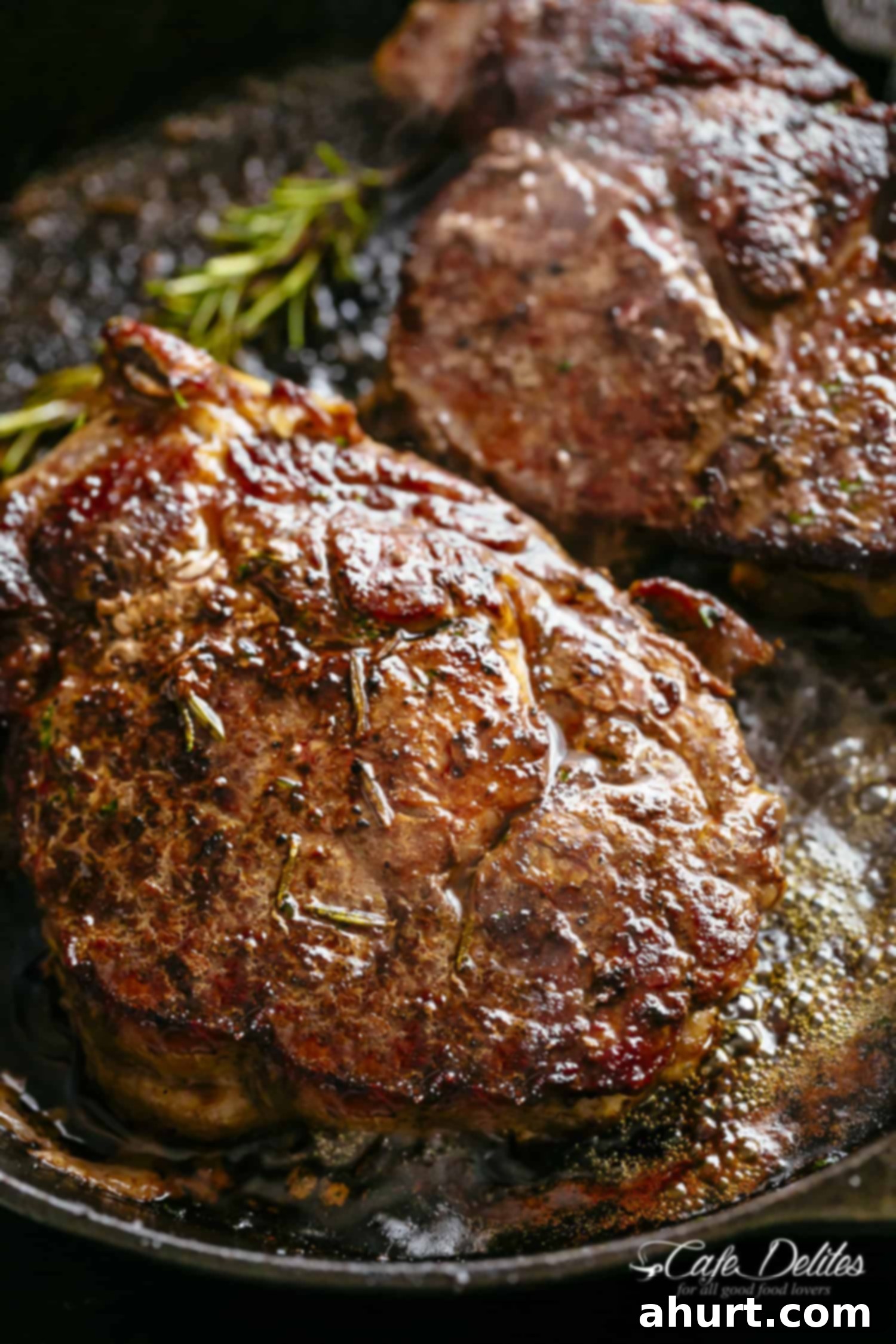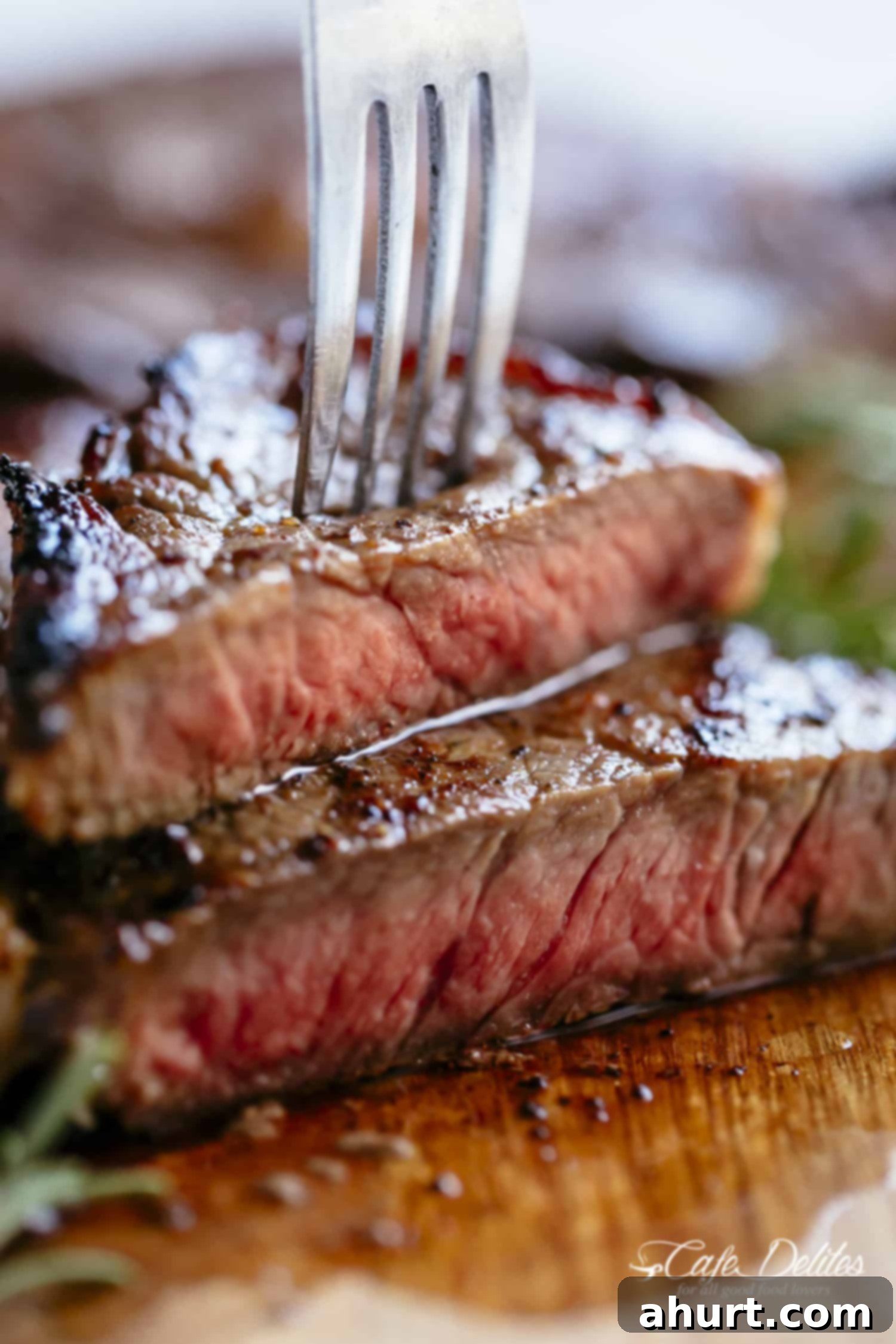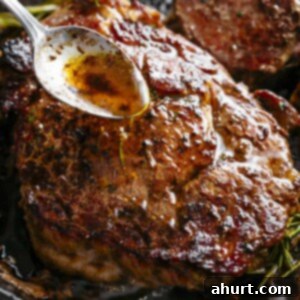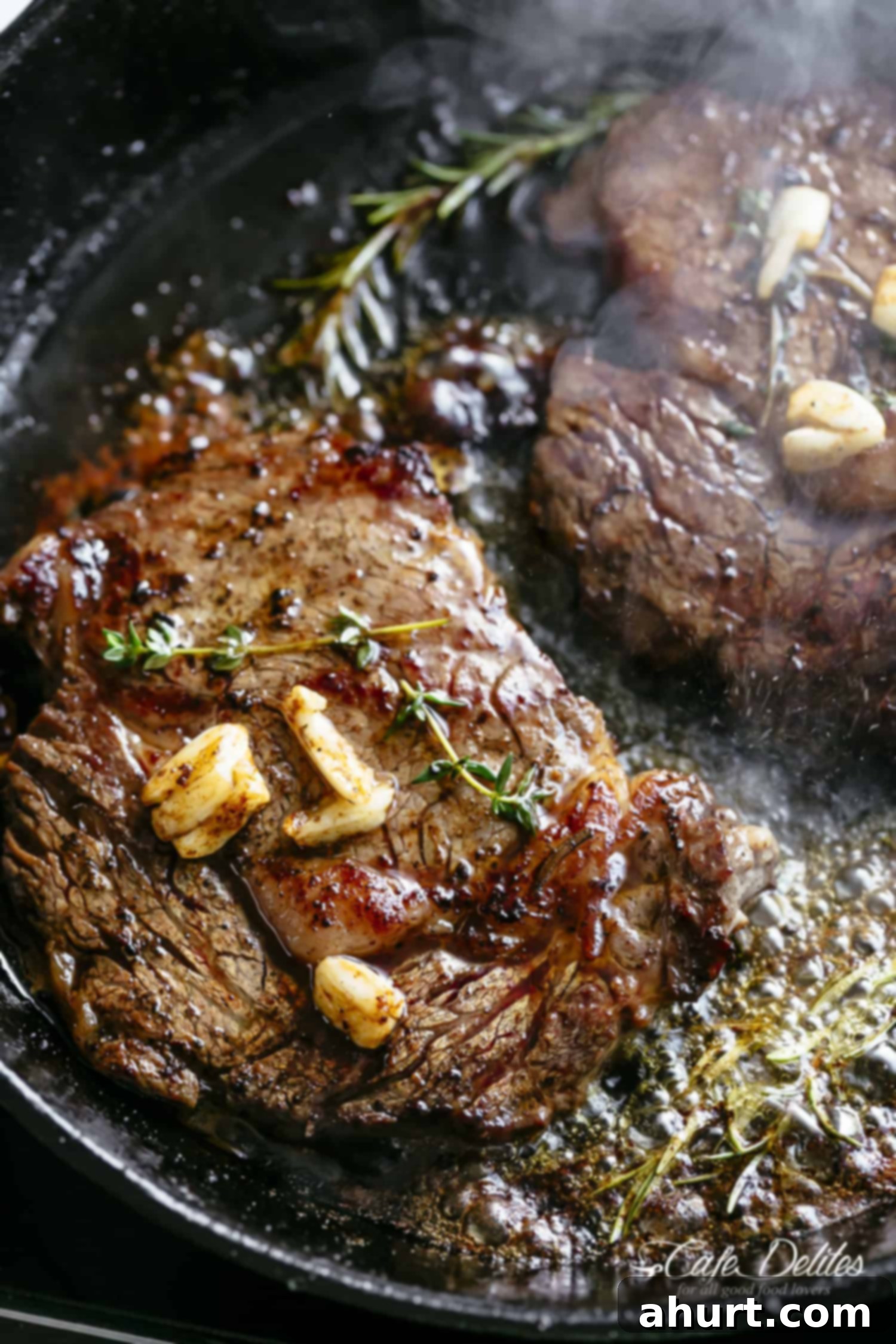Mastering the Perfect Pan-Seared Steakhouse Steak at Home
Imagine a steak so tender it melts in your mouth, with a perfectly golden, crispy crust and rich, savory flavors infused by aromatic butter. Now imagine making that exact steak in your own kitchen, without needing to make a reservation or pay exorbitant restaurant prices. This guide will show you how to prepare a juicy, butter-basted Steakhouse Steak right at home, delivering a truly exceptional dining experience.
Whether your preference is a succulent Ribeye with its beautiful marbling, a robust and flavorful New York Strip, or a hearty Sirloin or Rump cut, you can master the art of steakhouse-style cooking with simple techniques and a good pan. Forget complicated grilling or specialized equipment – our foolproof method focuses on pan-searing to golden perfection, followed by an irresistible butter basting that locks in moisture and infuses every bite with incredible flavor.
In under 20 minutes, from start to finish, you’ll have a mouthwatering steak dinner that rivals most restaurant offerings and is undoubtedly better than many steak recipes you’ve tried before. Get ready to impress yourself and your guests with a truly unforgettable meal.

The Science of a Perfect Steak: Why This Recipe Works
The secret to a truly perfect Steakhouse Steak lies in two critical techniques: the high-heat sear and the irresistible butter basting. These aren’t just cooking steps; they’re the foundation of flavor and texture that elevates a good piece of meat into an extraordinary one.
High-Heat Searing: The Maillard Reaction
Searing the steak in a blazing hot pan creates what chefs call the Maillard reaction. This chemical process is responsible for the rich, complex flavors and the appealing deep brown crust you find on restaurant-quality steaks. The intense heat quickly caramelizes the natural sugars and proteins on the surface of the meat, forming a flavorful crust that locks in the steak’s precious juices. This initial sear is crucial for developing the characteristic taste and texture that defines a great steak.
Butter Basting: Infusion and Moisture
Following the initial sear, the butter basting stage is where the magic truly happens. By reducing the heat and adding butter, garlic, and fresh herbs like thyme or rosemary, you create a rich, aromatic elixir. As you spoon this flavored butter over the steak, it not only continually moistens the meat, preventing it from drying out, but also deeply infuses it with layers of savory, herbaceous, and garlicky goodness. This constant bathing ensures every part of the steak benefits from the incredible flavors, resulting in a supremely tender and juicy interior.
You don’t need an outdoor grill, a fancy broiler, or any other special equipment beyond a good, heavy-bottomed pan and a few simple tips. This method teaches you how to cook a steak in a pan with complete confidence, guaranteeing tender, juicy results with an incredible crust, every single time.
Key Ingredients for Your Steakhouse Steak
Achieving a rich, buttery, pan-seared steakhouse experience starts with selecting the right ingredients. Each component plays a vital role in delivering that unforgettable flavor and texture:
- Steaks: The foundation of your meal. Choose high-quality cuts like:
- Ribeye: Known for its generous marbling, which renders beautifully during cooking, resulting in an exceptionally tender and flavorful steak. It’s often considered the king of steaks.
- New York Strip: Offers a perfect balance of tenderness and robust beefy flavor, with a good fat cap on one side that adds to its richness when rendered.
- Sirloin or Rump: A leaner, more economical option that still delivers great flavor and can be incredibly tender when cooked correctly using this method.
- Porterhouse or T-Bone: For those who love variety, these cuts feature both tenderloin (filet mignon) and New York strip separated by a T-shaped bone, offering two distinct textures and flavors.
Aim for steaks that are at least 1 to 1.5 inches thick for the best searing and internal temperature control.
- Butter: Essential for that signature steakhouse taste. Unsalted butter is preferred, allowing you to control the overall seasoning. It not only creates a golden crust but also acts as a carrier for the flavors of garlic and herbs during the basting process.
- Garlic: Lightly crushed cloves are key. As they sizzle gently in the foaming butter, they release deep, aromatic, and savory notes that permeate the steak. Avoid finely minced garlic, as it can burn easily at high temperatures.
- Fresh Herbs: Sprigs of thyme or rosemary are classic choices. They infuse the butter with a subtle earthiness and herbaceous aroma that beautifully complements the rich beef. Fresh herbs provide a depth of flavor that dried herbs simply can’t match.
- Olive Oil: Used for the initial sear. A good quality olive oil (or another oil with a high smoke point) helps prevent the butter from burning during the initial high-heat cooking.
- Salt and Pepper: Simple yet critical. Generous seasoning just before cooking enhances the natural flavor of the beef and contributes to the formation of that desirable crust.
Note: For precise measurements and a full list of ingredients, please refer to the recipe card section at the bottom of this article.
How To Make the Perfect Pan-Seared Steakhouse Steak
Follow these step-by-step instructions to achieve a flawless steakhouse-quality steak in your kitchen:
- Bring Steaks to Room Temperature: This is a crucial first step for even cooking. Remove your steaks from the refrigerator at least 20-30 minutes before you plan to cook them. This allows the meat to relax and ensures it cooks more evenly from edge to center, preventing a cold, undercooked middle with an overcooked exterior.
- Heat the Pan to Perfection: Place a large cast-iron skillet or other heavy-bottomed, oven-safe pan over medium-high heat. Cast iron is ideal because it retains heat exceptionally well, ensuring a consistent sear. Allow the pan to heat for several minutes until it’s smoking slightly. Add 1 tablespoon of olive oil and swirl to coat the surface. The oil should shimmer and almost smoke, indicating it’s hot enough for a proper sear.
- Season Generously: Just before placing them in the hot pan, generously season all sides of your steaks with salt and freshly ground black pepper. Don’t be shy with the salt; it’s essential for flavor and crust development. Pat the steaks dry with paper towels before seasoning for the best crust.
- Sear the First Side: Carefully lay the seasoned steaks into the screaming hot pan, laying them away from you to avoid splashes. Do not overcrowd the pan; if cooking more than two steaks, work in batches. Sear for 2-3 minutes without moving the steak. You’re looking for a deep, golden-brown crust. Resist the urge to peek or move the steak too early.
- Flip and Sear Again: Using tongs, flip the steaks and sear the second side for another 1-2 minutes. For an even, deep brown crust, you might flip them once more, allowing each side to develop maximum caramelization.
- Sear the Edges (Optional but Recommended): For thicker cuts, use tongs to hold each steak upright and sear the fat caps and sides for about 1 minute. This renders the fat, releasing incredible flavor and creating an all-around crispy texture.
- Add Butter and Aromatics: Reduce the heat to medium-low. Add 2 tablespoons of butter, 3 lightly crushed garlic cloves, and a few sprigs of fresh thyme or rosemary to the pan. The butter should begin to melt and foam.
- Infuse the Butter: Allow the butter to foam and gently fry the herbs and garlic for about 1 minute. This process releases their aromatic oils and deeply infuses the butter with incredible savory notes. Gently place the garlic cloves and herb sprigs on top of the steaks.
- Baste the Steaks: Carefully tilt the pan towards you (using an oven mitt to hold the handle) so the flavored butter pools. Use a large spoon to continuously baste the steaks with the hot, aromatic butter for 1-3 more minutes, or until the steak reaches your desired level of doneness. This constant basting ensures the meat remains juicy and absorbs all those incredible flavors. For well-done steaks, you might flip them a couple more times during basting to ensure even cooking.
- Rest and Repeat: Once your steaks are cooked to your liking, discard the spent aromatics. Transfer the steaks to a clean plate or cutting board. Immediately pour any remaining pan juices over them. This is a critical step: let the steaks rest for at least 5 minutes. Resting allows the juices, which have been pushed to the center by the heat, to redistribute throughout the meat, resulting in a supremely tender and juicy steak. If you have more steaks to cook, repeat the process, adding fresh oil, butter, garlic, and herbs for each batch.
For a truly memorable steak dinner, complement your Steakhouse Steak with delicious side dishes. Try the sweet-savory twist of Hasselback Herbed Garlic Butter Sweet Potatoes, or opt for something hearty like a Sausage Eggplant Lasagna with Ricotta Pesto for a more substantial meal. For a lighter yet still indulgent accompaniment, Spinach and Ricotta Zucchini Cannelloni adds a creamy, veggie-forward touch to round out the meal beautifully. A simple green salad with a sharp vinaigrette also makes an excellent, refreshing contrast.
Recipe FAQs & Steak Cooking Tips
When searing steak, it’s crucial to use an oil with a high smoke point to prevent it from burning and imparting a bitter flavor. Canola oil, grapeseed oil, vegetable oil, or refined coconut oil are excellent choices. Olive oil can also work, especially light olive oil, but extra virgin olive oil has a lower smoke point and is best reserved for finishing or dressings. We recommend adding oil directly to a hot, dry pan rather than oiling the steak itself, as this helps achieve a more even coating and prevents excess oil from smoking excessively.
While the “touch test” (feeling the firmness of the steak) can be useful with practice, the most accurate way to determine doneness is by using an instant-read meat thermometer. Insert the thermometer into the thickest part of the steak, avoiding any bones. Remove the steak from the pan when it’s 5°F below your desired final temperature, as it will continue to cook slightly while resting (this is called carryover cooking).
Here’s a guide to internal temperatures:
Rare: 120–125°F (50–52°C) – Very red, cool center.
Medium-Rare: 130–135°F (55–57°C) – Red, warm center (often preferred by steakhouses).
Medium: 140–145°F (60–63°C) – Pink, warm center.
Medium-Well: 150–155°F (65–68°C) – Slightly pink center.
Well-Done: 160°F+ (70°C+) – Little to no pink, firm throughout.
A heavy cast-iron skillet is by far the best choice for cooking steak on the stovetop. Its ability to retain and distribute heat evenly is unparalleled, which is essential for achieving a consistent, golden-brown crust (the Maillard reaction). Stainless steel pans are a good second option as they also handle high heat well. Avoid nonstick pans for searing steak; they generally don’t get hot enough to achieve proper browning, and the high heat required for searing can damage their nonstick coating.
Absolutely! This is a crucial step often overlooked. Patting your steak thoroughly dry with paper towels before seasoning and searing removes surface moisture. Moisture on the surface will cause the steak to steam rather than sear, preventing that desirable crispy crust from forming. A dry surface allows for direct contact with the hot pan, facilitating the Maillard reaction and a perfect crust.
For the best steakhouse-quality results with this pan-searing method, we recommend steaks that are at least 1 inch thick, ideally 1.25 to 1.5 inches. Thicker steaks allow more time for a beautiful crust to develop without overcooking the interior. Very thin steaks (less than 1 inch) tend to cook through too quickly, making it difficult to achieve a good sear while maintaining a medium-rare or medium center.

Watch Our Steakhouse Steak Recipe in Action!

Saved
Pin
Garlic Butter Basted Steakhouse Steak
Ingredients
For Steaks:
- 4 steaks 8 ounce steaks, 1 inch thick, rib-eye, scotch fillet, New York strip, porterhouse, sirloin or rump
- 1 pinch salt to season
- 1 pinch pepper to season
- 2 tablespoons olive oil divided
- 4 tablespoons butter divided
- 6 cloves garlic lightly crushed with the back of a knife, divided
- 6-8 fresh thyme sprigs or rosemary sprigs, divided
Instructions
-
Take steaks out of the refrigerator for at least 20 minutes before cooking to bring them to room temperature. This ensures more even cooking.
-
Heat a large cast-iron skillet or heavy pan over medium-high heat until it’s very hot and slightly smoking. Add 1 tablespoon of olive oil and swirl to coat. Generously season steaks all over with salt and pepper just before placing them into the hot pan.
-
When the pan begins smoking, lay the steak into the pan away from you (one or two at a time to avoid overcrowding) and cook for 2-3 minutes until a crisp, golden crust forms. Flip and sear the second side for another 1-2 minutes. Continue flipping once more to get a nice, even deep brown crust and crisp texture. For thicker steaks, use tongs to sear the fat caps and sides for about 1 minute, rendering the fat for added flavor.
-
Reduce heat to medium-low. Add 2 tablespoons of butter, 3 crushed garlic cloves, and a few sprigs of thyme or rosemary to the pan. Allow the butter to foam and gently fry the herbs and garlic for 1 minute to release their rich flavors into the pan.
-
Carefully tilt the pan towards you (using an oven mitt) so the flavored butter pools. Place the garlic cloves and herb sprigs on top of the steaks, then use a large spoon to baste the steaks continuously with the hot, aromatic butter.
-
Continue basting for 1 to 2 more minutes, or until the steak reaches your desired doneness (refer to temperature guide in FAQs). For well-done steaks, you may need to flip them a couple more times while basting until they reach your preference.
-
Once cooked, discard the thyme and garlic from the pan. Transfer the steaks to a plate or cutting board and pour the remaining pan juices over them. Let them rest for 5 minutes. This resting period is crucial for the juices to redistribute, ensuring a tender and juicy steak. Repeat the process for any remaining steaks, refreshing oil, butter, and aromatics as needed.
Chef’s Notes & Pro Tips
Nutrition Information
Nutrition information is automatically calculated and should only be used as an approximation. Exact values may vary based on ingredients and preparation methods.
